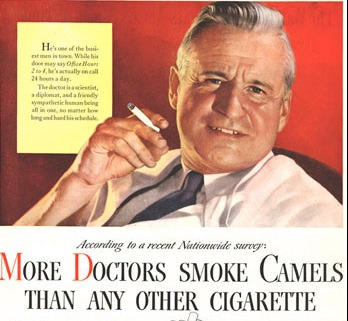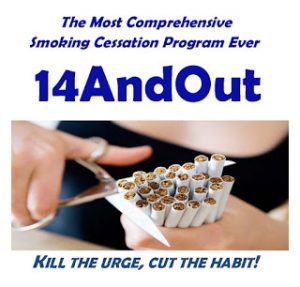80 Years of Sick Lies … Now Kick the Smoking Habit with Nutrition, Exercise and Mindset
11/25/2015 / By David Rice

In the 1930’s, American science and health professionals figured out that smoking causes lung cancer. There was irrefutable evidence. At that exact time and place in our history, there were many advertisements in journals and magazines featuring doctors endorsing their favorite brands of cigarettes–talking about how “roasty toasty” the flavor (Marlboro), how smoking aids with digestion, and how it is GOOD for your health. Seriously. The American Medical Association, working in tandem with the Food and Drug Administration, working in tandem with the Centers for Disease Control and Prevention, decided NOT to step in and stop ANY of these advertisements, and so BIG TOBACCO reigned on, having up to 20,000 American ALLOPATHIC LIARS tell their story about their favorite cigarette, for at least TWENTY MORE YEARS. Take a quick look at these atrocities. The commercial even shows the doctor lighting up the cigarette:
Camel’s 1950 Television Commercial:
https://www.youtube.com/watch?v=gCMzjJjuxQI
History of the Discovery of the Cigarette–Lung Cancer Link:
http://tobaccocontrol.bmj.com/content/21/2/87.full
After World War II, also in the 1950’s, Nazi scientists were hired by America to work on synthetic agriculture pesticides, using some of the same ingredients (Zyklon-B and fluoride) used to exterminate millions of Jews in the holocaust. These toxins would be sprayed on corn, soy, and yes, tobacco. These toxins, by the mid-1980’s, would be gene-infused into crops (genetic modification or “GMO”) so that the corn, soy and tobacco seeds and plants would CONTAIN TOXINS and be IMMUNE to being sprayed with them. This would increase profits for Big Tobacco and and for Big Pharma–that is, on the back end – for all the smokers who thought cigarettes were once healthy and will soon be visiting the lying doctors (and their prodigy) who sold them on it all, got them addicted in the first place, and will be using deadly and expensive surgery, chemotherapy and radiation on them, all which INCREASE the chances of getting MORE cancer. Who do you think created chemo? It’s all one HUGE SCAM:
As Vicky Batts writes in Hoax.news:
“By killing off healthy cells, chemotherapy sets patients up to be at a higher risk of developing cancer again within 10-15 years, if the chemo didn’t kill them the first time around. In fact, since the debut of chemotherapy, the number of secondary cancers has increased exponentially.”
http://www.naturalnews.com/052066_flu_shots_chemotherapy_health_care_fraud.html#ixzz3sKBK6jjq
Big Question: What do you get when you mix GM tobacco with ammonia and bleach?
Answer: http://www.naturalnews.com/039233_tobacco_ammonia_cigarettes.html
And so all these years the American Medical Association, which published the smoking doctors ads in JAMA, was holding the hands of millions of Americans and walking them down death’s corridor, all to make some easy cash. Do you really think it’s so much different today, in 2015? Do you really think, and think about this hard for a few seconds here … do you really think the FDA, CDC and AMA suddenly changed their ways one day, one year, and decided to protect the health of innocent Americans and stop destroying it for capital gains?
From the BMJ–British Medical Journal 2011:
The non-scholarly public was “slower than scholars and medical professionals to recognize tobacco harms.”
Part of that lag and total lack (of knowledge) “can be traced to campaigns mounted by the industry to manufacture doubt.”
Deaths caused by some of the world’s largest tobacco factories are calculated, and the value of a human life for a cigarette manufacturer is shown to average $10,000.
You’ve Reached the “Tipping Point”
Are you furious your government is so insidious that they would strategically plan the demise of your health for corporate profits, payouts and payoffs? Are you upset that the regulatory agencies never did apologize for promoting addictive nicotine-loaded and laced cigarettes for decades after SCIENCE proved smoking cigarettes causes lung cancer? How upset are you? Upset enough to try a real method to quitting cigarettes that’s natural, no side effects, and is the arch-rival NEMESIS of all these Big Tobacco lies?
Fine. Not quite yet. It’s time for you to read something very important. Set aside about ten minutes and gain some knowledge you need to have to have the motivation and the BLUE PRINT PLAN for ending your addiction. Here we go:
Read Excerpts from the original American History Abstract Here:
“Lung cancer was once a very rare disease, so rare that doctors took special notice when confronted with a case, thinking it a once-in-a-lifetime oddity. Mechanization and mass marketing towards the end of the 19th century popularized the cigarette habit, however, causing a global lung cancer epidemic. Cigarettes were recognized as the cause of the epidemic in the 1940s and 1950s, with the confluence of studies from epidemiology, animal experiments, cellular pathology and chemical analytics. Cigarette manufacturers disputed this evidence, as part of an orchestrated conspiracy to salvage cigarette sales. Propagandising the public proved successful, judging from secret tobacco industry measurements of the impact of denialist propaganda. As late as 1960 only one-third of all US doctors believed that the case against cigarettes had been established. The cigarette is the deadliest artifact in the history of human civilization.
Cigarettes cause about 1 lung cancer death per 3 or 4 million smoked, which explains why the scale of the epidemic is so large today. Cigarettes cause about 1.5 million deaths from lung cancer per year, a number that will rise to nearly 2 million per year by the 2020’s or 2030’s, even if consumption rates decline in the interim. Part of the ease of cigarette manufacturing stems from the ubiquity of high-speed cigarette making machines, which crank out 20,000 cigarettes per min. Cigarette makers make about a penny in profit for every cigarette sold, which means that the value of a life to a cigarette maker is about US $10,000.
Lung cancer has become a formidable disease, killing about 1.5 million people per year globally, extrapolating from a 2008 International Agency for Research on Cancer (IARC) risk assessment. The tragedy is magnified by the fact that the overwhelming majority of these deaths, around 95%, are entirely preventable. Lung cancer today is primarily caused by the inhalation of smoke from cigarettes, which is also why the disease was quite rare prior to the 20th century. Lung cancer was not even recognized medically until the 18th century, and as recently as 1900 only about 140 cases were known in the published medical literature.
The malady must have been occasionally misdiagnosed as tuberculosis (phthisis) or pneumonia or some other lung malaise, but we also know from detailed autopsy records in Germany that the disease cannot have been very common. Findings of primary lung tumours in the autopsied bodies of German research clinics rose dramatically in the second half of the 19th century, and even more dramatically in the first decade of the 20th. Isaac Adler summarised this evidence in 1912, in the world’s first monograph on lung cancer, noting that the incidence of malignant neoplasms of the lung seemed to show ‘a decided increase’. Adler mentioned the ‘abuse of tobacco and alcohol’ as one possible cause, while also commenting that the subject was ‘not yet ready for final judgment’.
Tobacco was apparently not even suspected as a cause of lung tumours until the final decade of the 19th century. In 1898, a medical student by the name of Hermann Rottmann in Würzburg proposed that tobacco dust—not smoke—might be causing the elevated incidence of lung tumours among German tobacco workers. Rottmann’s mistake was not corrected until 1912, when Adler proposed that smoking might be to blame for the growing incidence of pulmonary tumours. Lung cancer was still a very rare disease; so rare, in fact, that medical professors when confronted with a case sometimes told their students they might never see another. By the 1920s, however, surgeons were encountering the malady with increasing frequency, and started puzzling over what might be responsible. Smoking was commonly blamed, along with asphalt dust from newly tarred roads, industrial air pollution and latent effects from exposure to poison gas in the First World War or the global influenza pandemic of 1918–1919. These and a number of other theories were put forward as possible explanations for the rise of lung cancer, until evidence from multiple sources of enquiry made it clear that tobacco was by far and away the leading culprit.
In the middle decades of the 20th century, four distinct lines of evidence converged to establish cigarette smoking as the leading cause of lung cancer. These are outlined below.
Population studies
These were among the first and most convincing forms of evidence. Scholars started noting the parallel rise in cigarette consumption and lung cancer, and by the 1930s had begun to investigate this relationship using the methods of case-control epidemiology. Franz Hermann Müller at Cologne Hospital in 1939 published the first such study, comparing 86 lung cancer ‘cases’ and a similar number of cancer-free controls.4 Müller was able to show that people with lung cancer were far more likely than non-cancer controls to have smoked, a fact confirmed by Eberhard Schairer and Eric Schöniger at the University of Jena in an even more ambitious study from 1943.
These German results were subsequently verified and amplified by UK and American scholars: in 1950 alone, five separate epidemiological studies were published, including papers by Ernst Wynder and Evarts Graham in the USA and Richard Doll and A Bradford Hill in England. All confirmed this growing suspicion, that smokers of cigarettes were far more likely to contract lung cancer than non-smokers. Further confirmation came shortly thereafter from a series of prospective ‘cohort’ studies, conducted to eliminate the possibility of recall bias. The theory here was that by following two separate and initially healthy groups over time, one smoking and one non-smoking, matched by age, sex, occupation and other relevant traits, you could find out whether smoking was a factor in the genesis of lung disease.
The results were unequivocal: Doll and Hill in 1954 concluded that smokers of 35 or more cigarettes per day increased their odds of dying from lung cancer by a factor of 40. Hammond and Horn, working with the American Cancer Society on another large cohort study, concluded that same year that the link had been proven ‘beyond a reasonable doubt’.
Animal experimentation
This was a second key line of evidence. ‘Tobacco juice’ had been shown to cause cancer on laboratory animals since the first decade of the century, and a number of scholars had confirmed these results. The most active in this realm was the intrepid Angel H Roffo, founding director of Argentina’s Institute of Experimental Medicine for the Study and Treatment of Cancer, who in 1931 showed that smoke condensed from the destructive distillation of tobacco could cause tumours when smeared on the hairless skins of rabbits.
Roffo in the 1930s and early 1940s published dozens of articles (mainly in German and Spanish) implicating smoking in the genesis of cancer, prompting enthusiastic endorsement from the German public health establishment but also ridicule from the cigarette industry. German tobacco manufacturers even established an entire journal—Chronica Nicotiana—and a scientific ‘academy’, the Academia Nicotiana Internationalis, to buttress the fortunes of tobacco, then under siege from public health activists.
In 1953, a great deal of attention was given to an experiment by Ernst Wynder, Evarts Graham and Adele Croninger, showing that tumours could be generated by painting cigarette smoke tars onto the shaved backs of mice. Life magazine devoted several pages to the story, and Time cited Graham’s conclusion that the case against tobacco had now been proved ‘beyond any doubt’. Public confidence in tobacco was shaken, and stock prices of American cigarette manufacturers plummeted. Tobacco manufacturers saw this new ‘health scare’ as a mortal threat to their livelihood, and decided to organise a response.
On December 14, 1953, at the Plaza Hotel in Manhattan, CEOs of the six largest tobacco manufacturers in the USA (all but Liggett) met to plan a response. The outcome was a far-reaching plan to refute the accumulating evidence, using adverts, ‘white papers’, press releases and corporate schmoozing with popular science writers and journalists. Support for (industry-friendly) science was a vital part of this enterprise: cigarette manufacturers called for ‘more research’ to resolve a purported ‘controversy’, and set out to reassure the public that the companies were taking charge. That campaign was by and large a success, judging from the fact that per capita consumption rebounded from its dip in 1953. Cigarette consumption in the USA would in fact continue to grow throughout the 1960s and 1970s, peaking at about 630 billion sticks in 1982 before starting to decline.
Cellular pathology
A third line of evidence for the cigarette–cancer link came from cellular pathology. Pathologists in the 1930s had started noticing the capacity of cigarette smoke to cause ciliastasis—the deadening of the tiny whip or hair-like structures lining the upper airway passages, structures known to be responsible for wafting particulate contaminants out of the lungs. Suspicions started to grow that ciliastasis could cause cigarette smoke to become trapped in the lungs, causing cancer. Pathologists also started exploring whether damage from smoking could be discerned at the level of the cell. Anderson C Hilding in 1956 confirmed that smokers were experiencing pulmonary ciliastasis, but also that cilia were being deadened at precisely those parts of the lung where cancers were most likely to develop. Oscar Auerbach about this same time showed (from autopsy studies) that precancerous changes could be detected in the cells of smokers—even in those who had died from other causes.
Cancer-causing chemicals in cigarette smoke
A fourth line of evidence stemmed from the discovery of cancer-causing chemicals in cigarette smoke. Polycyclic aromatic hydrocarbons had been identified as carcinogenic constituents of coal tar in the 1930s, and the question then arose: might there not be similar compounds in cigarette smoke? Angel Roffo in Argentina was the first to identify polycyclic aromatic hydrocarbons in cigarette smoke from their distinctive spectrographic signatures, and for a time at least his was the most authoritative voice in this realm.
Roffo’s work was taken seriously even by consultants working for the industry. In 1947, in an internal report to the Lorillard company, makers of Old Gold cigarettes, John B Fishel of Ohio State University acknowledged the presence of ‘carcinogenic benzopyrene in tobacco tars’, citing Roffo as an authority. Tobacco industry laboratories conducted their own investigations: Brown and Williamson researchers identified benzpyrene in cigarette smoke in 1952, and by the end of the decade cigarette manufacturers had characterized several dozen carcinogens in cigarette smoke, including arsenic, chromium, nickel and a veritable zoo of polycyclic aromatic hydrocarbons (chrysene, methylcholanthrene, dibenzanthracene, dibenzacridene, etc). As Philip Morris research director Helmut Wakeham put it in 1961, carcinogens were found in ‘practically every class of compounds in cigarette smoke’.
The confluence of these diverse forms of evidence—from epidemiology, animal experiments, clinical observation and chemical analysis, combined with diminishing evidence for alternative explanations, prompted health and medical authorities throughout the world to publicly acknowledge a cigarette–cancer link. The American Cancer Society’s National Board of Directors in 1954 announced ‘without dissent’ that ‘the presently available evidence indicates an association between smoking, particularly cigarette smoking, and lung cancer’. The Public Health Cancer Association that same year advised stopping smoking as a way to prevent cancer, and cancer authorities in Norway, Sweden, Finland, Denmark and The Netherlands came to similar conclusions. UK cancer authorities came on board, as did the Joint Tuberculosis Society of Great Britain and Canada’s National Department of Health and Welfare. Sceptics were converted, and medical attention shifted from the question of ‘whether’ to the question of ‘how’—and what to do about it.
Researchers in the tobacco industry also became convinced of a cigarette–cancer link—though this was never admitted publicly. Claude Teague in his confidential 1953 ‘Survey of Cancer Research’, written for upper management at RJ Reynolds, makers of Camel cigarettes, concluded that the parallel rise in cigarette use and cancer had led to the suspicion that tobacco was ‘an important etiologic factor in the induction of primary cancer of the lung’. Teague observed that clinical data were confirming the relationship, and concluded that the large body of animal experimental work ‘would seem to indicate the presence of carcinogens’.
Teague was not the only tobacco insider conceding a hazard. Harris Parmele, Lorillard’s director of research, in 1946 had commented privately on how ‘Certain scientists and medical authorities have claimed for many years that the use of tobacco contributes to cancer development in susceptible people. Just enough evidence has been presented to justify the possibility of such a presumption’.
The American Tobacco Company in the summer of 1953 took the extraordinary step of sponsoring a series of secret animal tests in the laboratories of the Ecusta Paper Corporation, makers of much of the world’s cigarette paper, with the goal of finding out whether it was the tobacco leaf or the cigarette paper that was causing all this cancer. Their conclusion, distributed only privately, was that tobacco—and not the paper—was the culprit.
Tobacco industry insiders by the mid 1950s clearly knew their product was dangerous. In December of 1953, when Hill and Knowlton was exploring how to respond to the uproar surrounding the publication of carcinogens in cigarette smoke, one tobacco company research director commented in a confidential interview: ‘Boy! Wouldn’t it be wonderful if our company was first to produce a cancer-free cigarette. What we could do to competition!’ Another remarked on how fortunate it was ‘for us’ (ie, for cigarette manufacturers) that smokers were engaging in ‘a habit they can’t break’.
The mid-1950s cancer consensus was clearly (albeit privately) shared by the companies; and the reality of addiction was also starting to be conceded—at least in internal industry documents. UK cigarette makers also commented on the lung cancer consensus. Three leading scientists from British American Tobacco (BAT) visited the USA in 1958, for example, and found that with only one exception all of those consulted—including dozens of experts inside and outside the industry—believed that a cancer connection had been proved.
Alan Rodgman at Reynolds 4 years later confessed that while evidence in favour of the cancer link was ‘overwhelming’, the evidence against was ‘scant’.
Helmut Wakeham at Philip Morris about this same time drew up a list of dozens of carcinogens in cigarette smoke.
None of this was made public; indeed the tobacco industry throughout this time and for decades thereafter—until the end of the millennium—refused to admit any evidence of harms from smoking. No one can say precisely how many lives were lost as a result, but if the decline in per capita consumption that began with the US Surgeon General’s report in 1964 had begun instead in 1954, when the conspiracy to challenge the science was launched, millions of lives would have been saved.
The 1964 Surgeon General’s report, which recognized smoking as a cause of lung cancer in men, is often regarded as a turning point in the recognition of health harms from smoking. But the Surgeon General’s report was actually a kind of scientific anticlimax: from an evidentiary point of view the case against smoking had been closed by the end of the 1950s, and it was only the truculence and obstinacy of cigarette manufacturers that forced a blue-ribbon review by the federal government.
Charles S Cameron, Medical and Scientific Director of the American Cancer Society, put the matter nicely in a 1956 overview for the Atlantic Monthly, noting that if the same level of evidence had been arrayed against, say, spinach, no one would have objected to the banning of that plant from the national diet.”
Mike Adams, the Health Ranger and Editor-in-Chief of NaturalNews.com has this to say about 14AndOut Stop Smoking Course:
“14 & Out offers smokers a new approach to quitting the smoking habit for good – – an approach that frees you from all corporation chemicals and their physiological addictions. It does this by addressing smoking addiction with a multi-layered approach, reforming smoking behaviors, detoxifying the body from chemicals that promote addiction, and supporting the body’s healthy functioning with a sound nutritional approach that works with the brain’s natural chemistry to break addictions at a molecular level.”
Life without cigarettes in 60 minutes!
FREE TRAILER of the 60-MINUTE COURSE
14AndOut – The Natural Method
Watch this: http://programs.naturalnews.com/14AndOut__TV.htm
World Famous Nutritionist David Wolfe Recommends 14AndOut!
http://14andout.blogspot.com/2015/04/david-wolfe-recommends-natural-method.html
Other sources about 14AndOut and the “Stop Smoking King”
https://stopsmokingking.wordpress.com/
http://14andout.blogspot.com/2015/08/every-cigarette-takes-one-hour-off-your.html
Main sources for this blog:
http://tobaccocontrol.bmj.com/content/21/2/87.full
http://www.naturalnews.com/052066_flu_shots_chemotherapy_health_care_fraud.html#ixzz3sKBK6jjq
https://naturalnewstracker.wordpress.com/2015/11/15/train-your-brain-to-quit-smoking/
Tagged Under: 14&out, 14andout, ama fraud, best stop smoking aid, cdc fraud, cigarette lies, doctors endorse cigarettes, doctors promote cigarettes, fda fraud, history of tobacco, natural method, quit cigarettes, quit smoking, stop smoking king





















